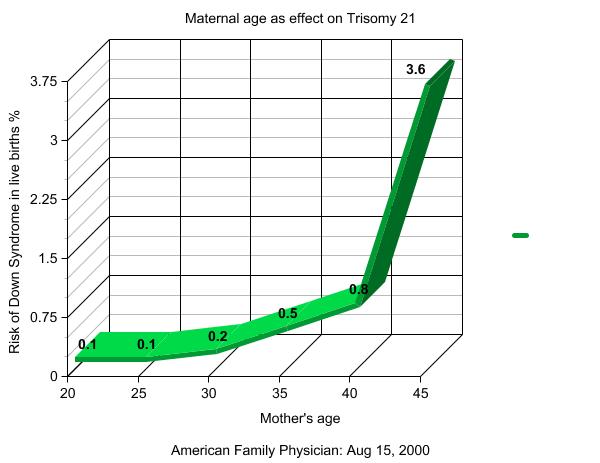Risk of chromosomal aneuploidy in relation to maternal age
Risk of chromosomal aneuploidy[edit | edit source]
The risk of non-disjunction defects in the fetus increases with the age of the mother. This is documented in the following picture (Fig. 1) and also (Graph 1.) This dependence is most clearly demonstrated in trisomic forms of Down syndrome, but a similar tendency can be demonstrated in other autosomal aneuploidies.
Figure 1: Risk of Down syndrome and other chromosomal aneuploidies in relation to maternal age
Graph 1: Risk of chromosomal aneuploidy (Down syndrome) in relation to maternal age
Causes[edit | edit source]
The cause of the rising risk, in relation to the age of the mother, is apparently a significant time delay from the beginning of the development of the egg to its maturation. As is known, all primary oocytes enter the first meiotic division before the birth of a girl and remain in the dictyotene phase until they enter the ovulatory cycle.
The older a woman is, the more likely it is that the meiotic apparatus or chromosomes in the egg will be damaged due to various external factors. Therefore, as a woman's age increases, the risk of meiotic nondisjunction increases with primary oocytes and thus also the risk of chromosomal aneuploidy in the fetus. For this reason, all pregnant women aged 35 and above are informed about the possibility of prenatal chromosome examination of the fetus.
The age of the father does not have such a significant effect on the risk of nondisjunction defects.
Links[edit | edit source]
Related articles[edit | edit source]
Použitá literatura[edit | edit source]
- KOČÁREK, Eduard, Martin PÁNEK and Drahuše NOVOTNÁ. Clinical cytogenetics I: introduction to clinical cytogenetics: investigation methods in clinical cytogenetics. 1st edition. Prague: Karolinum, 2006. 120 pp. Textbooks of the Charles University in Prague; ISBN 80-246-1069-8.


